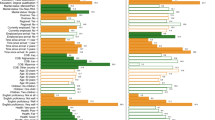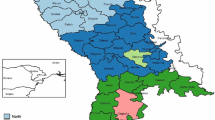Abstract
Many states have experienced a large influx of undocumented migrants in recent years. This phenomenon has created new demands on higher educational systems at the state level. Some states have passed legislation to restrict the access of undocumented migrants to higher public education whereas others provide access in various forms including in-state tuition. Our research examines a related issue that has not been researched much, namely, the impact of educational access on the location decisions of undocumented migrants in the U.S. Undocumented migrants appear to locate in states with high average median real per capita incomes. There is also evidence of clustering of undocumented migrants in states with large migrant networks. The effect of educational access on the percentage of undocumented workers in a state is mixed and small in most specifications, a finding perhaps indicative of a trade-off between competing priorities in the choice of location.
Similar content being viewed by others
Notes
“The appearance of Arizona and North Carolina on this list highlights another recent trend. In the past, the foreign-born population, both legal and unauthorized, was highly concentrated. But, since the mid-1990s, the most rapid growth in the immigrant population in general and the unauthorized population in particular has taken place in new settlement areas where the foreign born had previously been a relatively small presence (Passel 2005).”
The Council of Economic Advisors (2005, p. 110) notes “To obtain work, some undocumented immigrants resort to using false documents, such as fake Social Security cards or green cards.”
We do not consider factors such as distance and moving costs in calculating DPV ij as reliable data are largely unavailable in the case of undocumented migrants.
The coefficients of the logged independent variables are interpreted as elasticities.
This can be interpreted as a 1% increase in the total Hispanic population in a state leading to a 0.36% increase in the percentage of illegal immigrants in a state.
This finding, known as the “friends and neighbors effect,” is to be expected (Cebula et al. 1973).
References
Borjas, G. J. (1999). Immigration and welfare magnets. Journal of Labor Economics, 17(4), 607–637.
Bauer, T.K., Epstein, G.S., & Gang, I.N. (2002). Herd effects or migration networks? The location choice of Mexican migrants in the U.S. IZA Discussion paper series, No. 551.
Biswas R.R. (2005). Access to community college for undocumented immigrants: A guide for state policymakers. http://www.williamperezphd.com/articles/biswas-2005.pdf.
Carrington, W. J., Detragiache, E., & Vishwanath, T. (1996). Migration with endogenous moving costs. American Economic Review, 86(4), 909–930.
Cebula, R. J., & Alexander, G. M. (2006). Determinants of net interstate migration, 2000-2004. Journal of Regional Analysis and Policy, 27(2), 116–123.
Cebula, R. J., Duquette, C. M., & Mixon, F. G. (2013). Factors influencing the state-level settlement pattern of the undocumented migrant population in the U.S. Atlantic Economic Journal, 41, 203–213.
Cebula, R. J., Foley, M., & Boylan, R. (2014). The impact of unionization and other factors on undocumented migrant settlement patterns in the U.S. Applied Economic Letters, 21(4), 272–275.
Chin A., and Juhn, C. (2010). Does reducing college costs improve educational outcomes for undocumented migrants? Evidence from state laws permitting undocumented migrants to pay in-state tuition at state college and universities, NBER Working Paper 15932, April 2010, (Cambridge, Mass.: National Bureau of Economic Research).
Conway, K. S., & Houtenvile, A. J. (2003). Out with the old, In with the old: a closer look at younger versus older elderly migration. Social Science Quarterly, 84(2), 309–328.
Council of Economic Advisors. Economic Report of the President (February 2005). Washington: Government Printing Office.
Dougherty, K. J., Nienhusser, H. K., & Vega, B. E. (2010). Undocumented migrants and state higher education policy: the politics of in-state tuition eligibility in Texas and Arizona. The Review of Higher Education, 34(1), 123–173.
Dougherty, K., Nienhusser, H. K., & Kerrigan, M. R. (2006). Helping students enter and succeed: access, success, and accountability policies in the “achieving the dream” States. Community College Journal, 77, 42–47.
Flores, S. M., & Horn, C. L. (2009). College persistence and undocumented students at a selective public university: a quantitative case study analysis. Journal of College Student Retention, 11, 57–76.
Flores, S. M. (2010). State ‘dream acts’: the effect of in-state resident tuition policies on the college enrollment of undocumented Latino students in the U.S. Review of Higher Education, 33(2010), 239–83.
Gale, L. R., & Heath, W. C. (2000). Elderly internal migration in the U.S. revisited. Public Finance Review, 28(2), 153–157.
Hausman C., and Goldman V. (2001). Great expectations. New York Times, April 8, 2001. http://www.nytimes.com/2001/04/08/education/great-expectations.html?pagewanted=5&pagewanted=all.
Kaushal, N. (2008). In-state tuition for the undocumented: education effects on Mexican young adults. Journal of Policy Analysis and Management, 27(4), 771–792.
Nair-Reichert, U. (2014). Location decisions of undocumented migrants in the U.S. Journal of Regional Analysis and Policy, forthcoming.
National Conference of State Legislatures (2014). Allow in-state tuition for undocumented students. Retrieved July 1, 2014 from http://www.ncsl.org/research/education/undocumented-student-tuition-state-action.aspx.
Passel, J.S. (2005). Unauthorized migrants: Numbers and characteristics. http://www.pewhispanic.org/2005/06/14/unauthorized-migrants/.
Passel J.S. (2006). Size and characteristics of the unauthorized migrant population in the U.S. Pew Hispanic Center, Washington, DC. http://www.pewhispanic.org/2006/03/07/size-and-characteristics-of-the-unauthorized-migrant-population-in-the-us/.
Passel, J.S. and Cohn D. (2011) Unauthorized immigrant population: National and state trends, 2010. Washington, DC: Pew Hispanic Center, Februrary. http://www.pewhispanic.org/files/reports/133.pdf.
Perry, A. (2004). Philosophical arguments of membership: The case of undocumented immigrants and financial aid for postsecondary education. Unpublished doctoral dissertation, University of Maryland, College Park.
Renas, S. M. (1983). The cost of living, labor market opportunities, and the migration decision: more on problems of misspecification and aggregation bias. Annals of Regional Science, 17(1), 98–110.
Riew, J. (1973). Migration and public policy. Journal of Regional Science, 12(2), 65–73.
Saltz, I. S. (1998). State income taxation and geographic labor force mobility in the U.S. Applied Economics Letters, 5(5), 599–604.
Szelenyi, K., & Chang, J. (2002). ERIC review: educating immigrants: the community college role. Community College Review, 30(2), 55–73.
Tullock, G. (1971). Public expenditures as public goods. Journal of Political Economy, 79(5), 913–918.
U.S. Census Bureau (2005, 2006, 2007). Statistical Abstract of the U.S. Washington, D.C:U.S. Government Printing Office.
Vedder, R. K., Gallaway, L. E., Graves, P. E., & Sexton, R. (1986). A historical perspective in interregional migration in the U.S. In R. J. Krumm (Ed.), Housing and migration (pp. 101–24). Mount Pleasant: Blackstone Books.
Zota S. (2008). Unauthorized immigrants’ Access to higher education: Fifty States, different directions. Popular Government, Spring/Summer, 46-54.
Author information
Authors and Affiliations
Corresponding author
Rights and permissions
About this article
Cite this article
Nair-Reichert, U., Cebula, R.J. Access to Higher Public Education and Location Choices of Undocumented Migrants: An Exploratory Analysis. Int Adv Econ Res 21, 189–199 (2015). https://doi.org/10.1007/s11294-015-9522-3
Published:
Issue Date:
DOI: https://doi.org/10.1007/s11294-015-9522-3
Keywords
- Undocumented migrants or immigrants
- Illegal migration
- Migrant networks
- Network-based migration
- Migrant clustering, Migrant location decisions




